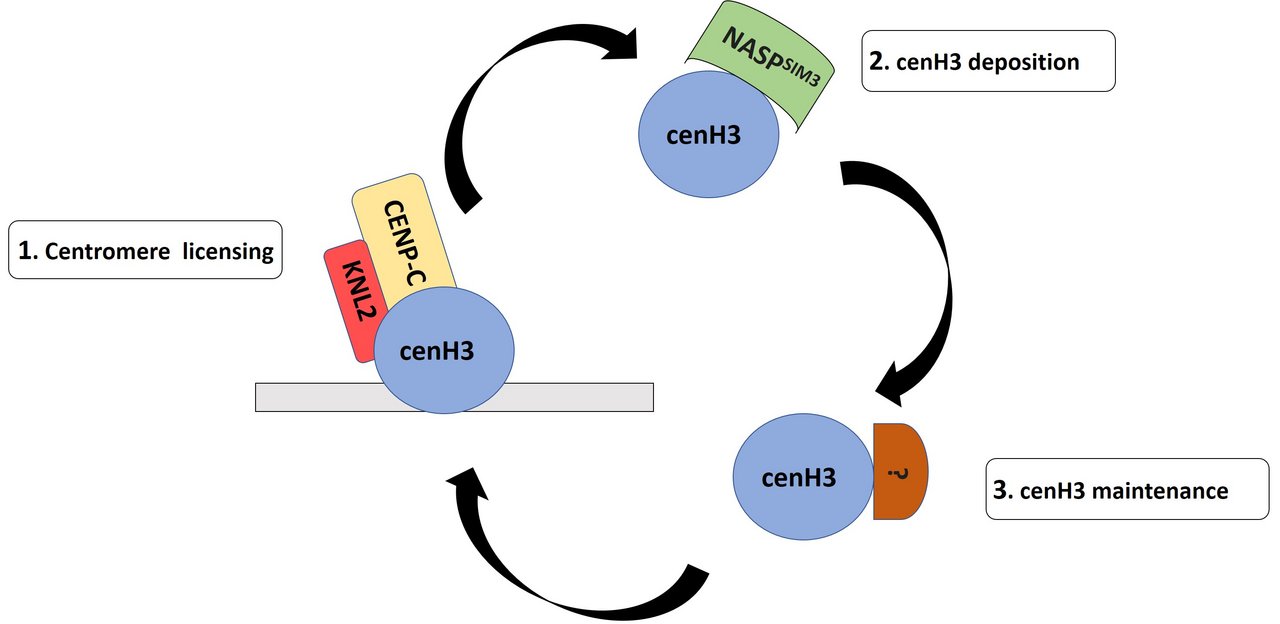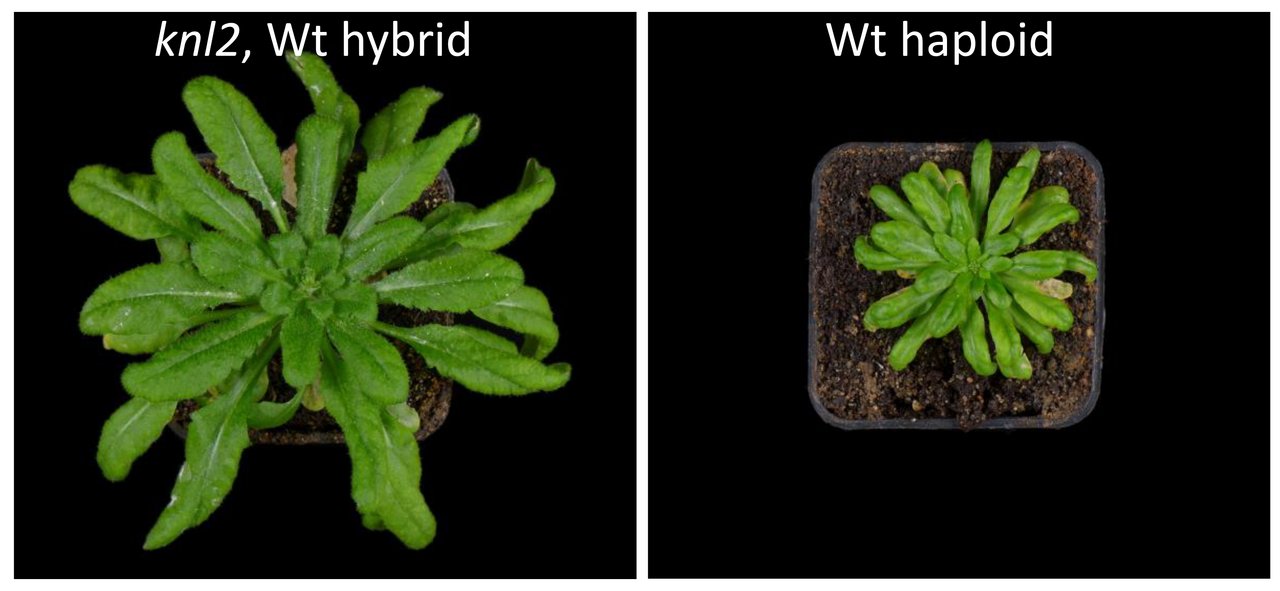Kinetochor-Biologie
Kinetochore befinden sich an den Zentromeren, an denen tandemartig angeordnete zentromerische DNA-Repeats eine kompakte Struktur höherer Ordnung bilden. Kinetochore sind multimere Proteinkomplexe, die durch vielfältige Interaktionen zwischen ihren Bestandteilen gekennzeichnet sind (siehe obiges Schema).
Die Forschungsgruppe Kinetochor-Biologie (KB) beschäftigt sich mit der Untersuchung der Organisation, Etablierung und Erhaltung des Kinetochor-Komplexes in Pflanzen.
Das Kinetochor ist ein großer Proteinkomplex (bis zu 100 Proteine), der sich während der Zellteilung an spezialisierten Chromosomendomänen, den Zentromeren, assembliert. Die Hauptfunktion dieses Komplexes ist es, die korrekte Segregation der Chromosomen während der Mitose und Meiose und damit die Genomstabilität in allen eukaryotischen Organismen sicherzustellen.
Die Zentromer-spezifische Histon H3-Variante CenH3 ist essentiell für die Kinetochorbildung und die Zentromerfunktion. Seine Deposition an den Zentromeren ist abhängig von CenH3-Assembly-Faktoren, Chaperonen, der Transkription zentromerischer Repeats und dem epigenetischen Status des zentromerischen Chromatins. Eine spezifische Manipulation des CenH3-Assembly-Faktors KNL2 führte in Arabidopsis thaliana zur Erzeugung von Doppelhaploiden (I. Lermontova, WO2017/067714). Die Produktion von Doppelhaploiden ermöglicht die Erstellung homogener Linien in nur einer statt in fünf oder mehr Generationen, wie es üblicherweise in der konventionellen Züchtung der Fall ist.
scroll top
Projekte
Unsere Hauptforschungsziele sind:
1. Aufklärung der der Kinetochor-Assemblierung und -Funktion zugrundeliegenden Mechanismen in Pflanzen
Wir fokussieren auf:
- die Aufklärung des cenH3 Beladungsprozesses in Pflanzen
- die Identifizierung und funktionelle Charakterisierung von neuen Komponenten des Kinetochor-Komplexes
- die funktionelle Analyse von Protein-Protein-Interaktionsnetzwerken der Kinetochor-Komponenten
- die Aufklärung der epigenetischen Regulation bei der Kinetochor-Assemblierung
cenH3-Beladungsprozess
In den meisten Eukaryoten ist die Kinetochore-Ausbildung von der zentromerischen Variante des Histons H3, cenH3, abhängig. Der Beladung mit cenH3 erfolgt bei A. thaliana in drei Stufen: Initiation, Einbau und Erhaltung. (1) An der Initiierung des cenH3-Einbaus sind der Lizenzierungsfaktor Kinetochore Null 2 (KNL2) und andere Komponenten beteiligt (Lermontova et al., 2013). (2) Anschließend wird cenH3 durch Chaperon-Proteine wie NASPSIM3 an den Zentromeren deponiert (Le Goff et al., 2020). (3) Die spezifischen Mechanismen/Faktoren zur Stabilisierung und Erhaltung von neu eingebautem cenH3 sind noch nicht bekannt.
2. Die Etablierung einer effizienten Methode zur Erzeugung von Haploiden basierend auf der Manipulation von Kinetochor-Proteinen
Wir fokussieren auf:
- die Optimierung des KNL2-basierten Haploiden-Induktionsansatzes in Arabidopsis und Aufklärung des Mechanismus
- Übertragung des KNL2-basierten Haploiden-Induktionsansatzes auf Nutzpflanzen
Generierung von Haploiden und Doppelhaploiden basierend auf KNL2-Manipulationen
Die Kreuzung von A. thaliana-Mutanten für das Kinetochore-Protein KNL2 mit Wildtyp führt zur Generierung von Haploiden. (Lermontova, I.: Generation of haploid plants based on KNL 2. (IPK-Anmeldung), Veröffentlichung: 27.04.2017, IPK-Nr. 2015/01. WO2017/067714 (2017)).
3. Analyse der Auswirkung von Umweltfaktoren auf den Kinetochor-Assemblierung
Wir fokussieren auf:
- die Untersuchung der Auswirkungen von Umweltbedingungen auf die Heterochromatinstruktur, die Kinetochor-Assemblierung und die Effizienz der Haploiden-Induktion
Temperatur- und Lichtstress beeinflussen die Struktur des Heterochromatins
Stressbedingungen wie hohe Temperatur und Licht induzieren eine Dispersion des Heterochromatins in A. thaliana.
Um unsere Forschungsziele zu erreichen, verwenden wir eine Kombination aus molekularbiologischen, biochemischen, physiologischen, zytologischen und bioinformatischen Methoden und Verfahren.
scroll top
Mitarbeitende
scroll top
Publikationen
Kalidass M, Jarubula V G, Ratnikava M, Chandra J R, Le Goff S, Probst A V, Esposito S, Grasser K D, Bruckmann A, Gagneux J F, Prosée R F, Rutten T, Schubert V, Demidov D, Lechner E, Steiner F A, Genschik P, Lermontova I:
Ubiquitin-dependent proteolysis of KNL2 driven by APC/CCDC20 is critical for centromere integrity and mitotic fidelity. Plant Cell 37 (2025) koaf164. https://dx.doi.org/10.1093/plcell/koaf164
Kalidass M, Vaculíková J, Chandra J R, Králová B, Jarubula V G, Kara Öztürk S D, Demidov D, Schubert V, Potesil D, Palecek J J, Lermontova I:
The C-terminal SUMOylation-dependent regulation of αKNL2 governs its centromere targeting and interaction with CENH3. Plant Commun. (2025) Epub ahead of print. https://dx.doi.org/10.1016/j.xplc.2025.101617
Majolo Willers H:
Functional characterization of RNA polymerases IV and V in the transcriptional regulation of centromeric repeats in Arabidopsis thaliana. (Bachelor Thesis) Berlin, Berliner Hochschule für Technik, Studiengang Biotechnologie (2025) 61 pp.
Yadala R:
Identification and characterization of EMB1674, as a novel KNL2 variant: revealing its centromere targeting mechanism and critical role in plant-specific kinetochore assembly. (PhD Thesis) Halle/S., Martin-Luther-Universität Halle-Wittenberg, Naturwissenschaftliche Fakultät III Agrar- und Ernährungswissenschaften, Geowissenschaften und Informatik (2025) 124 pp.
Yalagapati S P, Ahmadli U, Sinha A, Kalidass M, Dabravolski S, Zuo S, Yadala R, Rutten T, Talbert P, Berr A, Lermontova I:
Centromeric localization of αKNL2 and CENP-C proteins in plants depends on their centromere-targeting domain and DNA-binding regions. Nucleic Acids Res. 53 (2025) gkae1242. https://dx.doi.org/10.1093/nar/gkae1242
Crhak Khaitova L, Mikulkova P, Pecinkova J, Kalidass M, Heckmann S, Lermontova I, Riha K:
Heat stress impairs centromere structure and segregation of meiotic chromosomes in Arabidopsis. eLife 12 (2024) e90253. https://dx.doi.org/10.7554/eLife.90253
Ramakrishnan Chandra J, Kalidass M, Demidov D, Dabravolski S A, Lermontova I:
The role of centromeric repeats and transcripts in kinetochore assembly and function. Plant J. 118 (2024) 982-996. https://dx.doi.org/10.1111/tpj.16445
Yalagapati S:
Centromere targeting mechanism of KNL2 protein variants through analysis of their interaction with centromeric DNA. (Master Thesis) Guntur, India, Biotechnology at Vignans Foundation for Science, Technology & Research (2024) 58 pp.
Ahmadli U, Kalidass M, Crhak Khaitova L, Fuchs J, Cuacos M, Demidov D, Zuo S, Pecinkova J, Mascher M, Ingouff M, Heckmann S, Houben A, Riha K, Lermontova I:
High temperature increases centromere-mediated genome elimination frequency and enhances haploid induction in Arabidopsis. Plant Commun. 4 (2023) 100507. https://dx.doi.org/10.1016/j.xplc.2022.100507
Jarubula V G:
Interaction mapping analysis of E3 ubiquitin ligases with Kinetochore Null2 in Arabidopsis thaliana. (Master Thesis) Köthen, Hochschule Anhalt, Fachbereich Angewandte Biowissenschaften und Prozesstechnik (2023) 44 pp.
Kuo Y-T, Câmara A S, Schubert V, Neumann P, Macas J, Melzer M, Chen J, Fuchs J, Abel S, Klocke E, Huettel B, Himmelbach A, Demidov D, Dunemann F, Mascher M, Ishii T, Marques A, Houben A:
Holocentromeres can consist of merely a few megabase-sized satellite arrays. Nat. Commun. 14 (2023) 3502. https://dx.doi.org/10.1038/s41467-023-38922-7
Schönau L:
Analyse der CENH3 Expression in verschiedenen Sorten von B. napus. (Bachelor Thesis) Jena, Ernst-Abbe-Hochschule Jena, Fachbereich Medizintechnik und Biotechnologie, Studiengang Biotechnologie (2023) 41 pp.
Schubert V, Weißleder A, Lermontova I:
Simultaneous EYFP-CENH3/H2B-DsRed expression is impaired differentially in meristematic and differentiated nuclei of Arabidopsis double transformants. Cytogenet. Genome Res. 163 (2023) 74-80. https://dx.doi.org/10.1159/000533317
Ahmadli U, Sandmann M, Fuchs J, Lermontova I:
Immunolabeling of nuclei/chromosomes in Arabidopsis thaliana. In: Caillaud M-C (Ed.): Plant cell division: methods and protocols, 2nd. ed. (Series: Methods in molecular biology, Vol. 2382) New York [u.a.]: Springer US (2022) ISBN 978-1-0716-1743-4, 19-28. https://dx.doi.org/10.1007/978-1-0716-1744-1_2
Demidov D, Lermontova I, Moebes M, Kochevenko A, Fuchs J, Weiss O, Rutten T, Sorge E, Zuljan E, Giehl R F H, Mascher M, Somasundaram S, Conrad U, Houben A:
Haploid induction by nanobody targeted ubiquitin-proteasome-based degradation of EYFP-tagged CENH3 in Arabidopsis thaliana. J. Exp. Bot. 73 (2022) 7243–7254. https://dx.doi.org/10.1093/jxb/erac359
Möbes M:
Optimierung einer quantitativen Reverse-Transkriptase-PCR Methode zur Analyse niedrig-exprimierter Gene in Nutzpflanzen, basierend auf B. napus. (Bachelor Thesis) Köthen, Hochschule Anhalt, Fachbereich Angewandte Biowissenschaften und Prozesstechnik (2022) 48 pp.
Moebes M, Kuhlmann H, Demidov D, Lermontova I:
Optimization of quantitative reverse transcription PCR method for analysis of weakly expressed genes in crops based on rapeseed. Front. Plant Sci. 13 (2022) 954976. https://dx.doi.org/10.3389/fpls.2022.954976
Sinha A:
The CENPC-k and CENPC motif dependent targeting of proteins to the centromere using EYFP as a marker. (Master Thesis) Kiel, Christian-Albrechts-Universität zu Kiel (2022) 56 pp.
Yadala R, Ratnikava M, Lermontova I:
Bimolecular fluorescence complementation to test for protein-protein interactions and to uncover regulatory mechanisms during gametogenesis. In: Lambing C (Ed.): Plant gametogenesis: methods and protocols, 1st. ed. (Series: Methods in molecular biology, Vol. 2484) New York [u.a.]: Humana Press (2022) ISBN 978-1-0716-2252-0, 107-120. https://dx.doi.org/10.1007/978-1-0716-2253-7_9
Zuo S:
Plastome, repeatome and kinetochore protein evolution in land plants. (PhD Thesis) Brno, Masaryk University (2022) 176 pp.
Zuo S, Yadala R, Yang F, Talbert P, Fuchs J, Schubert V, Ahmadli U, Rutten T, Pecinka A, Lysak M A, Lermontova I:
Recurrent plant-specific duplications of KNL2 and its conserved function as a kinetochore assembly factor. Mol. Biol. Evol. 39 (2022) msac123. https://dx.doi.org/10.1093/molbev/msac123
Capitao C, Tanasa S, Fulnecek J, Raxwal V K, Akimcheva S, Bulankova P, Mikulkova P, Khaitova L C, Kalidass M, Lermontova I, Scheid O M, Riha K:
A CENH3 mutation promotes meiotic exit and restores fertility in SMG7-deficient Arabidopsis. PLoS Genet. 17 (2021) e1009779. https://dx.doi.org/10.1371/journal.pgen.1009779
Houben A, Demidov D, Lermontova I, Fuchs J, Weiss O, Meier K:
Generation of haploids based on mutation of SAD2. (Patent), Veröffentlichung: 24.03.2021, IPK-Nr. 2018/06. EP3794939. (2021).
Municio C, Antosz W, Grasser K, Kornobis E, van Bel M, Eguinoa I, Coppens F, Bräutigam A, Lermontova I, Bruckmann A, Zelkowska K, Houben A, Schubert V:
The Arabidopsis condensin CAP-D subunits arrange interphase chromatin. New Phytol. 230 (2021) 972-987. https://dx.doi.org/10.1111/nph.17221
Sorge E, Demidov D, Lermontova I, Houben A, Conrad U:
Engineered degradation of EYFP-tagged CENH3 via the 26S proteasome pathway in plants. PLoS One 16 (2021) e0247015. https://dx.doi.org/10.1371/journal.pone.0247015
Dvořák Tomaštíková E, Rutten T, Dvořák P, Tugai A, Ptošková K, Petrovská B, van Damme D, Houben A, Doležel J, Demidov D:
Functional divergence of microtubule-associated TPX2 family members in Arabidopsis thaliana. Int. J. Mol. Sci. 21 (2020) 2183. https://dx.doi.org/10.3390/ijms21062183
Ishii T, Juranić M, Maheshwari S, Bustamante F O, Vogt M, Salinas-Gamboa R, Dreissig S, Gursanscky N, How T, Demidov D, Fuchs J, Schubert V, Spriggs A, Vielle-Calzada J P, Comai L, Koltunow A M G, Houben A:
Unequal contribution of two paralogous CENH3 variants in cowpea centromere function. Commun. Biol. 3 (2020) 775. https://dx.doi.org://10.1038/s42003-020-01507-x
Le Goff S, Keçeli B N, Jeřábková H, Heckmann S, Rutten T, Cotterell S, Schubert V, Roitinger E, Mechtler K, Franklin F C H, Tatout C, Houben A, Geelen D, Probst A V, Lermontova I:
The H3 histone chaperone NASPSIM3 escorts CenH3 in Arabidopsis. Plant J. 101 (2020) 71-86. https://dx.doi.org/10.1111/tpj.14518
Boudichevskaia A, Houben A, Fiebig A, Prochazkova K, Pecinka A, Lermontova I:
Depletion of KNL2 results in altered expression of genes involved in regulation of the cell cycle, transcription, and development in Arabidopsis. Int. J. Mol. Sci. 20 (2019) 5726. https://dx.doi.org/10.3390/ijms20225726
Demidov D, Heckmann S, Weiss O, Rutten T, Tomaštíková E D, Kuhlmann M, Scholl P, Municio C M, Lermontova I, Houben A:
Deregulated phosphorylation of CENH3 at Ser65 affects the development of floral meristems in Arabidopsis thaliana. Front. Plant Sci. 10 (2019) 928. https://dx.doi.org/10.3389/Fpls.2019.00928
Kalinowska K, Chamas S, Unkel K, Demidov D, Lermontova I, Dresselhaus T, Kumlehn J, Dunemann F, Houben A:
State-of-the-art and novel developments of in vivo haploid technologies. Theor. Appl. Genet. 132 (2019) 593–605. https://dx.doi.org/10.1007/s00122-018-3261-9
Zelkowski M, Zelkowska K, Conrad U, Hesse S, Lermontova I, Marzec M, Meister A, Houben A, Schubert V:
Arabidopsis NSE4 proteins act in somatic nuclei and meiosis to ensure plant viability and fertility. Front. Plant Sci. 10 (2019) 774. https://dx.doi.org/10.3389/fpls.2019.00774
scroll top




